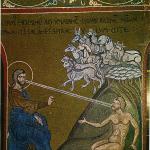Decembrist is a plant with beautiful and delicate flowers, blooming on the eve of Catholic Christmas. Flowering lasts almost the entire winter, as the flowers fade and replace each other. A single bud can last up to 3 days.
Now, thanks to numerous breeders, the flower petals have become varied in their shades:
- White;
- Orange;
- Raspberry;
- Coral.
History of a flower
 The Decembrist originally came to us from the tropical forests of Southern Brazil. So he likes to struggle on fallen trees or other plants not high above the ground.
The Decembrist originally came to us from the tropical forests of Southern Brazil. So he likes to struggle on fallen trees or other plants not high above the ground.
This forest cactus receives its nutrients with the help of its leaf segments, absorbing light and moisture from the environment.
Quite a lot of time has passed, but the flowers remember their biological homeland, and therefore they bloom at the beginning of winter.
Important! For good growth The Decembrist needs to create for him the biological rhythm of his homeland and then annual flowering will be guaranteed.
What signs and superstitions are there?
There are many different signs associated with the flowering of a plant. But, despite superstitions, this plant still lives in many of our people’s homes, and they delight them with its beautiful and delicate blooms.
After all, not a single Christmas is complete without his participation. Its flowering in winter period it's like magic, it's like summer has returned to you personal window sill even though it’s bitterly cold outside.
| Signs | Superstitions |
| If the Decembrist bloomed its buds in mid-December, then next year will be successful in family affairs. | The flowering of the Decembrist in mid-spring will attract a lack of money to the family, problems in the work team and the death of all plans for the future. |
| If the first bud opened in the first ten days of December, then in next year The family can expect many positive experiences. | Some nationalities call Schlumbergera “Muzhegon”, since not a single man gets along with him. |
| If flowering begins earlier than first month of winter, then a pleasant acquaintance awaits the florist. | A strong spring increase in the leaf mass of a flower is considered to indicate that someone in the family is sick and is actively fighting this disease. |
| If flowering begins in October, then this threatens to receive a profit or inheritance, or an addition to the family. | A girl who grows a zygocactus will most likely remain an old maid. |
| The more positive emotions there are in the family, the more beautiful and magnificent the Schlumbergera flowering will be. | The death of a flower signals that death may come to the family. |
| For people involved in various kinds of creativity, the opening of flowers in due time will mean that new solutions will be open to him in his work. | Distant ancestors noticed one feature of a flower - if it appears in the house negative person, then it not only drops buds, but can also dry out the leaf segments. After this man leaves, the Decembrist comes to life again. |
But if you believe all the signs and superstitions that people have come up with regarding flowers, then flowers should not grow in the house at all. But they carry only positive emotions and with proper care they do not die. And there is no connection between the flower and bad omens.
Important! If there is a zygocactus in the house, then peace and tranquility will live in it forever.
Is it true that the Decembrist can indicate death?
This is one of the negative signs that has existed since ancient times. It is believed that the dying flower does not go to another world on its own, but takes one of the apartment’s residents with it.
But this is just a relic from the past, because a Schlumbergera growing in a house cannot take someone with it to the kingdom of death. The Decembrist dies from improper care, and not for other reasons.
Important! The illness and death of a person is absolutely not related to the death of the plant and you should not be afraid to have it in your home or office.
What does it mean if Schlumbergera blooms in April?
 There's nothing wrong with that scientific point vision does not respond. Since the Decembrists are divided into two subspecies, which have two different periods flowering:
There's nothing wrong with that scientific point vision does not respond. Since the Decembrists are divided into two subspecies, which have two different periods flowering:
- Schlumberger– flowering occurs in December.
- Ripsadolis, in the photo, sparva blooms in April.
The appearance differs in the structure of the flower, Schlumbergera blooms with a flower consisting of three layers of petals emerging from one another. And thanks to its winter flowering, it is called the Decembrist or Christmas cactus.
Ripsadolis blooms with a single-tiered flower resembling a daisy around mid-spring and people also call it the Easter cactus. Since its flowering occurs on Orthodox Easter.
Therefore, the flowering of the Decembrist in April will mean only one thing: that the gardener has bloomed ripsadolis on the windowsill, since behind it there was a corresponding proper care.
The meaning of a flower in astrology
 Astrologers believe that this plant can absorb numerous conflicts that arise between people. They suggest that the flower is suitable:
Astrologers believe that this plant can absorb numerous conflicts that arise between people. They suggest that the flower is suitable:
- Young married couples who are just getting used to each other;
- It is good to place it in the nursery, as it can put the baby in a creative mood;
- Helps the family avoid attracting negative guests to their home;
- To create a good festive atmosphere;
- The flower is a talisman that can overcome many difficulties.
When purchasing this flower for your home, you should not think about bad things that may occur due to it. It is worth remembering that the plant can die due to poor care, and this will not threaten any of the people living in the house.
Magic properties
In this forest cactus, its magical nature is clearly visible. And therefore, the flower will be a good talisman that will serve as protection for the home. Therefore, its place is on the window closest to the entrance. Thus, the Decembrist will protect the house from uninvited and negative people.
What does a plant mean in Feng Shui?
 Some flower growers have a question about how best to choose a place in the house so that it suits the Decembrist and meets the requirements of Feng Shui.
Some flower growers have a question about how best to choose a place in the house so that it suits the Decembrist and meets the requirements of Feng Shui.
The chosen place in the apartment or office does not matter, the main thing is that the flower grows well and blooms according to the description. The main point will be its presence in the house, since the Decembrist:
- Fills the home atmosphere with comfort and good mood.
- Protects the home from negative emotions.
- Helps improve family relationships.
This plant is simply necessary for people in a house where many guests come or in an office where many visitors come.
Can I keep it at home?
This question is quite easy to answer. This flower deserves a place of honor among other flowers that live in our homes.
People buy Schlumbergera and enjoy its flowering, and a good growth of shoots in the spring only indicates that the flower is being properly cared for. And the flowering of the Decembrist, when the blizzard sings its songs outside the window, generally looks like a miracle during Christmas. After all, we all know what is beautiful blooming flower cannot influence our course of life, it is influenced by the person himself.
Useful video
Find out more in the video below:
Conclusion
If you properly care for this delicate flower, then during the winter cold it will give its love to the gardener and delight him with its beautiful blooms.
Many novice gardeners are convinced that a cactus is a prickly “pet” that loves the sun and is afraid of excess moisture. But beautiful flower the Decembrist is able to destroy these established ideas and prejudices.
Where did this strange name come from? How difficult is it to achieve flowering? How should a popular plant be cared for? What superstitions accompany its cultivation? Our article will tell you about all this and much more.

The generally accepted name of the flower is zygocactus. There is also another botanical name - Schlumbergera. It was awarded in honor of the French scientist Frederick Schlumberger, who was the discoverer of this variety of cacti.
In Russia, the plant is called the Decembrist or Rozhdestvennik because of its peculiarity of producing bright inflorescences in winter frosts. December and January blooms are due to the fact that in nature zygocactus blooms in the middle of summer, which in South American latitudes coincides with the Russian winter.
At first, Schlumbergera had exclusively red flowers. However, after breeding work florists were able to grow plants with pinkish, white, lilac, and yellow clusters. More recently, the Decembrist variety appeared on the market, in which flowers of different colors coexist.
This beautiful tropical South American plant is an epiphytic cactus. IN natural nature it grows on the root formations or trunks of Brazilian trees, forming real armfuls of flowers on hanging stems.
In general, the natural growth conditions of the Decembrist look as follows.
- Cacti are constantly in a semi-shaded environment (due to the fact that they grow under the canopy of trees). Naturally, this cannot but affect their cautious attitude towards direct sunlight.
- Schlumbergera are located on branches or roots, therefore, the requirements for soil composition are minimal. The plant does not need a rich complex of various micro- and macroelements and other useful substances.
- Since zygocactus grows in the humid climate of tropical forests, it is necessary to provide appropriate conditions in the room where the container with the plant will be placed.
As can be understood from the above, Decembrist is significantly different from “classic” cacti. Accordingly, it is necessary to provide favorable care for the plant, taking into account certain conditions and requirements. If everything is done correctly, the tropical guest will delight you with flowering for decades.
Plant species
In total, several species of Schlumbergera have been discovered. But there are very, very many hybrids and plant varieties. And this list is constantly growing due to the appearance of new copies. But we will list only the most basic varieties of Decembrist.
- Schlumbergera truncatus (truncated). The growth of an adult plant reaches half a meter. The stalks are long (up to 300 mm) and consist of several segments with pronounced teeth. flowering plant completely covered with clusters of flowers of white, pinkish, lilac or violet color. In their place, small fruits of a bright red hue are subsequently formed.
- Schlumbergera bucklei (bucklei). This zygocactus is less tall than the previous Decembrist variety. The stems are branched, dark green, shiny. There are no spines, instead there is a light edge. Flowers are large – up to 80 mm, different shades. You can purchase yellow varieties of this variety of Christmas tree.
- Schlumbergera Russelliana (Russelliana). Small cactus up to 300 mm in height. The stems are well developed, without spines, divided into flattened, shiny segments. The plant is grown in hanging pots, since the shoots can reach a length of 100 cm. The flowers are large, their color can be reddish, pinkish, carmine or purple.
- Schlumbergera gaertneri (Gertner). This zygocactus is quite large. The stem segments alone can reach 60-70 mm in length. Main feature This type of Decembrist has huge buds that resemble bells with pointed petals. The color of the flowers is bright red with an orange tint.
- Schlumbergera opuntioides (prickly pear). As the name suggests, the plant is very similar to prickly pear, that is, a cactus. The stem segments are very fleshy and covered with spines. During the flowering period (early spring), this variety of Decembrist is also covered with pink-violet buds.
If you want to please yourself with more daring and unusual varieties of Schlumbergera, then start growing hybrid varieties. The most popular include Madonna Dance, Madama Butterfly, Pasadena, Golden Cream. The beauty of their flowers will amaze all lovers of house plants.

This indoor flower quite unpretentious in care. But from compliance important rules and principles will depend on how intensely the plant blooms and how long your green “pet” will stand on the windowsill. Let's look at the aspects of care in more detail.
Lighting
The epiphytic cactus prefers bright and at the same time diffused lighting. Optimal conditions– places next to windows facing east or northeast. But the south side doesn't count ideal solution. But if it is not possible to achieve a diffuse light regime, then the flower is shaded.
During the period of budding and active flowering, the container with Schlumbergera should not be turned or even moved. Otherwise, the plant will get rid of the flowers. But when it retires, you can and should regularly unwrap the pot so that the stems turn green evenly.
Humidity and temperature
Decembrist is extremely tenacious and unpretentious to temperature conditions. A houseplant will withstand 35-degree heat and a drop in temperature to + 2 without any special physical and moral losses. However, there are also optimal performance this parameter is +18-25 degrees. It is under such conditions that the flower feels especially comfortable.
In order for the zygocactus to bloom especially intensively and delight others with its bright greenery, experts advise placing it in a cooler place (no higher than +16 degrees) in September-November. But just before flowering, it is moved to a warm place to form beautiful and healthy buds.
The tropical guest is not afraid of drafts. Therefore, in the summer months, a pot with zygocactus can be taken out to open balcony for ventilation or even take it with you to the dacha. The only condition is not to expose the flower to direct sunlight.
Schlumbergera, unlike “classic” cacti, loves high humidity air. This is why the plant needs to constantly have a shower with a spray bottle: hot weather– several times a week, in winter – 1-2 times every 30 days.
Watering
Proper care of zygocactus also includes adherence to the watering regime. The latter is conventionally divided into 3 periods, each of which differs in certain nuances and aspects.
- Bloom. During these months (December-February) the plant requires frequent, but moderate watering. You can tell that a flower wants to “drink” when the soil dries 1-3 centimeters deep. At the same time, it is strictly forbidden to fill the pot, otherwise the cactus will simply begin to rot, especially if the room is cool enough.
- D about and after flowering. To begin the formation of buds, the intensity of watering is reduced. Some gardeners generally sharply limit the moisture of the flower in order to redirect its forces not to stemming, but to budding. In the period after flowering (March-early summer), you should adhere to the same watering regime as during flowering.
- Hot time of year. In summer, the plant goes dormant, so water it when the soil substrate is almost completely dry. But we should not forget about spraying, or rather, about the shower. To do this, move the pot to the bathroom and direct the jets directly onto the leaves and stems. At this moment the soil should be covered with a plastic bag.
Do not water the delicate plant with tap water. It contains a huge amount of chlorine and calcium compounds that are harmful to the home cactus. Make sure to use settled boiled water for irrigation.

Under natural conditions, most nutrients Zygocactus receives from the tree on which it grows. And this is a rather modest “diet”, so it is generally accepted that the Decembrist is indifferent to vitamin and mineral supplements.
And yet, you can and should feed Schlumbergera, if, of course, you want to enjoy longer flowering. To do this, it is worth purchasing cactus fertilizers containing nitrogen, potassium and phosphorus compounds in certain proportions.
From March to August, when the Decembrist flower fades and begins intensive stemming, the plant is fed twice a month. Please note that the dosage must be taken 2 times less than what is written in the instructions. After all, the Christmas tree, as we have already said, is different from its prickly counterparts.
Transfer
Decembrist flower is not a very capricious plant, however, it also needs a transplant. Moreover, the younger the zygocactus, the more often it needs to be moved to another landing capacity. But an adult pet no longer needs annual transplant procedures - one transplant within a five-year period is enough for him.
This procedure is carried out after the flowering period - at the beginning of spring, so that by December the plant will be fully rooted, gain strength and prepare for the formation of buds. If you are behind on time, it is better to postpone the transplant until next year.
For planting, purchase a shallow but wide container. Its diameter is 2 cm larger than the previous pot. This ratio must be maintained if the Christmas tree is grown as an ampel (hanging) flower.
It is highly advisable to make small holes in the planting container for drainage and excess liquid to flow out. Otherwise, the roots of the plant may rot under conditions of excess moisture.
As for the soil, it should be relatively fertile, light, lush, permeable to air and water. The acidity level is weak. You can buy such soil in a store (labeled “For succulents” or “For cacti”), but it is better to make it yourself.
For this you will need:
- 1 part turf;
- 1 part sand;
- 2 parts leaf soil;
- ½ part of crushed coal;
- ½ part crushed brick;
- a little bit wood ash(for disinfection).
A drainage layer (one third of the total volume) is placed at the bottom of the landing tank. Then the soil is poured out, and after that the extracted plant is placed. Rotten roots must first be removed. That's it, the flower is ready for life in a new pot!
Trimming
Caring for a flower correctly means trimming it regularly, or rather, pinching it. This clarification is important because the removal of unsightly, painful or spoiling appearance cutting of stems occurs manually, without the use of scissors. To create a beautiful crown and ensure more abundant flowering, you need to unscrew the excess shoots using rotating movements.
Typically, the pinching procedure is carried out immediately after the flowering of a home cactus. But some gardeners skip this period and prune at the beginning of summer, combining it as necessary with the propagation of Schlumbergera.

Zygocactus is so beautiful at the moment of flowering that many owners have a desire to propagate it and place bright pots throughout the house. As we said above, you can combine this process with pruning a green bush.
The simplest and most common way to obtain a new plant is cuttings. In this case, the following sequence of actions must be observed.
- Using circular movements, disconnect the stem with 2-3 links (segments) from the flower.
- Dry the prepared cuttings for three days at normal temperature and natural light.
- Prepare small planting containers with the correct soil composition. Deepen the shoots into the ground.
- Cover the container with a glass jar or polyethylene, thereby creating greenhouse conditions.
- Place the pots in a shaded and not too warm place (+20 degrees) for 30 days. Moisten the soil daily and ventilate the plant.
Another method of propagation is grafting. It is used very infrequently, since it is labor intensive and has numerous nuances. But if this doesn’t scare you, then try growing a new Decembrist by replanting a shoot to the prickly pear.
To do this, you need to split the prickly pear stem and insert a pointed shoot into the socket. After this, the joint is fixed with a needle and additionally tied with tape. In approximately 2 weeks, the Decembrist will grow together with the mother’s body.
What to do if the Decembrist does not bloom

So, we figured out when the Decembrist blooms. However, some florists never wait for the coveted inflorescences in the winter months. Why does this happen and how can you help the Christmas tree get bright and attractive bunches of flowers?
Among the reasons for the lack of flowers, experts point out poor-quality (not meeting the plant’s requirements) soil, low air humidity, excessive shade, and lack of nutrients. All these factors need to be analyzed and eliminated.
Another question is how to “force” Schlumbergera to bloom at home?
You need to prepare in advance and do the following:
- choose a planting container that is not too wide (so that the flower is cramped);
- do not place the pot in a too warm place - optimal temperature is +16 degrees (in a cool microclimate, flowering will last longer);
- exclude serious temperature changes;
- put the pot with the zygocactus in one place and refuse to move it or turn it over (otherwise the buds will fall off);
- carry out pruning (pinching) in advance and do not break off the stems in October-November, otherwise you may not get buds at all;
- organize additional lighting in the room, if there is a shortage in the autumn-winter period sunlight(you can place the pot next to the lighting fixture);
- refuse to fertilize in September, since otherwise the plant will form stems rather than buds;
- reduce the intensity of watering during the formation of buds (October-November), but when the plant blooms, the volume of water can be slightly increased, but very carefully.
All these recommendations will help you achieve abundant flowering Decembrist. And, of course, it is necessary to follow the above-described principles of care so that the zygocactus feels great not only during budding, but throughout the year.
Diseases and pests
Decembrist is quite resistant to attacks harmful insects. And yet, some problems happen if you don’t take care of your green “pet.” What pests are considered the most dangerous and how to deal with them in order to prolong the life of the zygocactus?
The most common disease of the Decembrist is fungal fusarium. Pathogenic microorganisms through the soil and scratches penetrate the cactus, which leads to rotting of the roots. You can defeat the disease with the help of fungicides, for example, Bayleton.
Another common pathology is bacterial late blight, which manifests itself in the form of a dark spot, which subsequently invades more and more new areas of the stem. It will not be possible to cure the affected areas, so the easiest and most correct thing to do is to remove the diseased processes so that the infection does not spread further.

The Decembrist flower usually does not cause any particular inconvenience to gardeners. But we cannot exclude the possibility of some problem situations associated with the growth of leaves and stems, as well as flowering. We have already talked about some things, but some things should be said additionally.
Table 1. Problems with growing zygocactus.
| Problem | Reasons | Solving the problem |
| The flower withers | The pot is placed next to a hot radiator, which causes the leaves to become wrinkled. One more probable cause– excessive watering. | You need to move the pot to a cooler place (however, if you do this during flowering, the flowers will fall off). You should also reduce the intensity of watering, replacing it with abundant spraying. |
| Leaves and buds fall | The main reason is excessive watering. | It is necessary to reduce the intensity of watering. After some time, you need to remove the flower from the container, remove the rotten roots and replant it in new soil. |
| The stems and leaves of the plant turn red | The main reasons: excessive watering, incorrectly selected fertilizing, direct sun rays, drafts. | It is important to exclude all of the listed provoking factors. You should also keep the Decembrist in a cool room, away from drafts and bright sunlight. |
| Plant growth has slowed down | The main reasons: moisture deficiency, untimely application of fertilizing to the soil, too bright light. | From the beginning of spring to the end of summer, you need to add special fertilizers to the soil. You should also regularly water, spray and wash the leaves and stems with warm, settled water. |
Signs and superstitions associated with the Decembrist
Many people are superstitious and tend to associate problems in their lives with certain events, for example, with the flowering of plants. Signs have also been found for the Decembrist flower. Such superstitions can be positive and negative.
Positive signs:
- the cactus bloomed on time (in December), therefore, everything will be fine in relations with relatives;
- the buds opened at the beginning of winter - the coming year will bring many positive emotions;
- the flowers appeared a little prematurely - a new acquaintance is coming soon;
- flowering began a month before the usual dates - expect to receive an inheritance, marriage or the birth of a child.
Negative signs:
- the Christmas tree bloomed in mid-spring - superstitious people advise preparing for such unpleasant events as lack of money, difficulties at work, illness or death of relatives;
- finding a flower in the house means constant quarrels in the family, divorce from her husband, a young girl will not be able to find a chosen one (some believe that the Decembrist is a “husband’s man”).
There are no objective reasons that would limit or exclude the presence of Schlumbergera in the house. The plant is not poisonous, does not have thorns (unlike other cacti), and does not harm children and furry pets. Therefore, do not pay attention to various superstitions!
Conclusion
The Decembrist flower will decorate any home, especially in the winter months, when the flowering period begins. Caring for this plant is not very difficult, the main thing is to achieve the creation of the usual for zygocactus natural conditions. The result of all efforts will be bright buds and lush greenery.
Decembrist flower - how to care? Given houseplant is not whimsical and capricious, however, in order for it to please you with its excellent flowers, you still need to follow certain rules, which we will talk about below.
Decembrist flower - benefits and harm. What care does this indoor plant need?
For the Decembrist, tropical forests are a familiar environment South America. The plant usually blooms with juicy red or silvery-white flowers. However, experts managed to breed bushes with lilac, orange and coral flowers. Let's consider how to care for the Decembrist flower:

- During the flowering period, Decembrist needs careful watering; the ground should not become dry. And after flowering, until April, watering should be reduced. During spring and summer, Decembrist should be watered only after the soil has dried. From the beginning of autumn until new buds appear, the bush should be moved to cool conditions and watered rarely. IN summer time It is advisable to spray the flower so that it does not dry out. Ultraviolet light can destroy the Decembrist, in summer period better to take it out fresh air, however, place it in partial shade. The plant is unpretentious to temperature conditions; it can easily tolerate temperatures from +2 to +37 degrees. The most comfortable temperature conditions for the Decembrist it is considered +18 - +25 degrees. The Decembrist is also unpretentious in feeding, but for full growth they are still necessary. A mixture of potassium, nitrogen and phosphorus dissolved in water is considered optimal for this plant. About a month before the buds should appear, you need to stop feeding. How does the Decembrist flower reproduce? Reproduction, according to advice experienced gardeners
, this plant should be carried out by cuttings. The technology is as follows:
- There is no need to use cutting objects, just use your hand (but very carefully) to tear off the last few segments of the bush branch. Dry the cuttings for at least three days. Plant them shallowly in the ground and cover the top to create a greenhouse effect. Place the container with cuttings in a well-ventilated, shaded place. The young Decembrist must be kept at a temperature of +15 - +20 degrees.
What does the Decembrist flower bring to its owners? Signs of the “Decembrist in the house.”
It is considered an excellent sign if the bush blooms on time. This means that everything will be fine in the family throughout the next year, and the residents of the house will experience profit and good luck. However, if the Decembrist began to bloom earlier than planned, or vice versa, it is in no hurry to throw out the flowers, then this promises trouble. It is likely that in this case the owners will begin to be haunted by diseases, negative events, lack of money and other misfortunes. Therefore, if people noticed that the Decembrist did not bloom in December, then they mentally prepared themselves for the worst.
It is very bad if the Decembrist began to wither without obvious reasons, and even worse if he died altogether. Superstitious people fear this sign most of all. A dried plant promises the imminent death of one of the family members. It is likely that death will occur unexpectedly and suddenly. This is why many are simply afraid to have a Decembrist at home.
If the Decembrist began to get sick, despite proper care, it was believed that this was due to the visit of some ill-wisher. Maybe even the person did not deliberately think about anything bad, but his negative energy was present. You need to take a closer look at your friends; it is likely that some of them have an insincere attitude towards you. That is, the Decembrist allows you to determine the goodwill of your guests.
Similar interesting articles.
Very unusual flower Decembrist, or scientifically - Schlumberger, got its name due to its flowering. It is in December that the zigzag leaves of the plant are covered with bright buds of red or hot pink color. This flower is not only an excellent decoration in an apartment or house, but also a predictor of various events that can happen to the inhabitants of a home and various superstitions are associated with it.

Positive signs
This plant is literally imbued with the atmosphere of the house. The flower senses the slightest changes that occur in the destinies of household members. Any housewife caring for a flower can determine by the state of the Decembrist what will happen in her family, what changes are expected on the horizon.
Most a positive omen is considered to be the flowering of a plant. On time, the Decembrist bloomed and said how beautiful and cozy atmosphere reigns in the house. The spouses get along very well with each other, and the children grow up in love and understanding. There is a sign that if the Decembrist bloomed in the first winter month, then next year will be happy and full of pleasant events.
If the plant blooms ahead of schedule, this may indicate a pleasant acquaintance or changes in life. Early flowering may portend an increase in salary. It is also possible to receive an inheritance from a distant relative.
Negative signs
Late flowering of a plant may portend trouble. This can be related to either an individual family member or everyone living in the house. Perhaps there will be troubles at work or with the child in school. The Decembrist, which bloomed later than expected, speaks of a strained family relationships, conflicts that occur between spouses. Since the flower reacts to the slightest changes in people’s biofield, perhaps you should take a closer look at the behavior of your loved ones.
Late flowering can be a harbinger of disease and money problems.
If you notice that the Decembrist began to fade, while the plant was well cared for and you did not forget to water it, then this is a harbinger of great trouble. A dead plant symbolizes the death of one of the family members. This may be sudden death or death from an accident.
Superstitions
For a long time, the Decembrist flower has been a kind of sensor for people, which reacted to a slight change in the biofield in their homes. If a person was sick in the house, then they began to take very careful care of the plant. Our ancestors believed that if the flower did not die, the patient would definitely recover.
Our ancestors noticed one peculiarity associated with the flower: when a person with bad energy appears in the house, he becomes lethargic and looks lifeless. Such people were no longer invited into the house and we tried to communicate with them less.
If there are frequent scandals in the house, people live in lies and mistrust, then the Decembrist may not bloom at all. When wearing a Decembrist flower, you cannot swear or use foul language. Bad thoughts and actions can negatively affect the life of the plant.
Positive qualities of the Decembrist
Keeping such a flower in the house is not difficult; the Decembrist is quite unpretentious in care, but it will not allow you to forget about yourself. The flower is a kind of energetic contactor with all family members. And reacts to positive and negative qualities, which are hidden under the human body.
And if peace and tranquility reigns in your home, then this plant will certainly delight you with its unusual and colorful flowers, which create a festive atmosphere on the eve of the New Year and Catholic Christmas.
I would like to note that this plant can absorb negative energy prevailing in the room and transform it into positive emotions that every person experiences. Decembrist is perfect for office premises, because it is at work that people often need positive emotions, which unite the team and help improve productivity.
The Decembrist awakens in the soul of every person such feelings as:
- kindness,
- care,
- attention,
- compassion,
- tenderness,
- Love.
Very often such a flower can be seen in psychologists' offices. Decembrist is the plant that helps cope with mental illness and gives you vitality.
The flower loves it when people talk to it, consult with it and talk about current events.
Astrology
Astrologers consider Decembrist a very controversial plant. It is thanks to their unusual leaves, which resemble arrows, the Decembrist looks stern and unfriendly. But the leaves themselves are so soft, and during flowering they are also unusually beautiful, that you want to constantly admire this flower and definitely have it in your home.
It was precisely by the bright flowering in the winter cold that the Decembrist seemed to contradict nature itself and contrast delicate flowers severe frosts.
Astrologers note that the flower helps people understand that it is possible to establish any contact and resolve an urgent conflict, but to do this it is worth changing your attitude towards the world around you.
How to make "Decembrist" bloom - Everything will be fine - Issue 501 - 11/24/2014 - Everything will be fine
Caring for the Decembrist at home
Anna Usova how to breed a Decembrist flower
DECEMBER IN THE HOUSE. Signs and superstitions associated with the Decembrist
Decembrists are blooming. Care. How to make it bloom. How to prolong flowering. How to avoid buds falling off
The Decembrist, according to astrologers, is responsible for the creative side of human life. The flower helps develop body plasticity and speech plasticity. Thanks to the plant, everyone can learn to correctly express their thoughts and be heard by their opponents.
That is why the Decembrist is placed in the rooms where the child grows up. The energy of the flower has a beneficial effect on the development of the child and provides an influx of creative ideas and positive thoughts.
Is it worth keeping the plant at home?
Signs and superstitions about the Decembrist flower can make a person think about the advisability of keeping it at home. But it should be remembered that any sign has a recommendatory nature, which makes you think about life and understand the reason for the failures that have arisen. After all, a wilted flower can indicate hidden illnesses in the household and, thanks to it, it becomes possible to prevent the development of the disease in time.
You should also pay attention to your circle of acquaintances: perhaps some of them treat you unkindly, but carefully hide it. At home, this is determined quite easily, because, having excluded such people from visiting the house, the Decembrist comes to life and looks healthy.
So keeping a plant at home is very useful. And, seeing how it blooms, you don’t have to worry about your family and friends.
Decembrist flowering in spring
If the Decembrist blooms in the spring, then the sign associated with this event does not bode well. This means that bad events will happen in your life. You may have money problems or health problems.
Superstitions are not always groundless, try to sort out your life and get examined. After all, if a plant blooms at home ahead of schedule, then you need to pay attention to intrafamily problems and health problems. Take an interest in the affairs of your relatives; perhaps they have some troubles that they are keeping quiet.
So, if you are wondering whether it is possible to keep Decembrist at home, then our opinion is definitely yes. You won't find a better home detector and assistant.
Decembrist, or Schlumbergera cactus, is a succulent beautifully flowering shrub entangled in a whole heap various secrets and riddles. Therefore, many are afraid to have this plant in their home.
Decembrist flower: why is it dangerous and can it be kept in the house?
The Decembrist produces fragile and delicate buds in the first winter month, on the eve of the New Year and Christmas holidays, for which he received his common nickname.
Decembrist blooms at the end of December, on New Year's Eve and Christmas
The main myths and prejudices are associated specifically with the flowering of this succulent.
Video: how the Decembrist is useful
Signs and superstitions
There are many fears and superstitions associated with the Decembrist, some of them negative and positive. Negative signs associated with the following events:
- if suddenly a plant withers and dies for no apparent reason, then the death of a loved one should be expected in the near future;
If the Decembrist withers and dries up, then there will soon be a funeral in the house
- belated flowering, later than usual, portends financial difficulties and serious health problems, and also speaks of impending discord in the family, conflicts and quarrels;
If the Decembrist blooms in spring or summer, then financial difficulties are coming
- foliage dropped abruptly indicates damage to the home and its inhabitants.
Suddenly dropped foliage indicates damage to the house.
Decembrist grew up with my grandmother. She always said that if a flower looks sickly, lethargic and does not set buds, then there is negative energy in the house coming from the people living there (they often quarrel and have conflicts).
Decembrist, which does not bloom, looks sick and stunted, thus reacts to the negative energy in the house
Positive signs are interpreted as follows:

Buds that appear in November promise an addition to the family or a wedding.
Video: superstitions and signs associated with the Decembrist
Objective reasons
No objective reasons have been found to limit or exclude the detention of the Decembrist in residential premises. Although it belongs to the epiphytic cacti, it does not even have spines and is not capable of harming curious children or nosy pets.
Decembrist leaves are not poisonous and have no thorns
Feel free to take the Decembrist into your home. With proper care, it will bloom regularly and in a timely manner, despite all signs and superstitions.


















